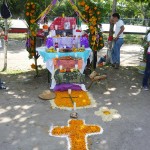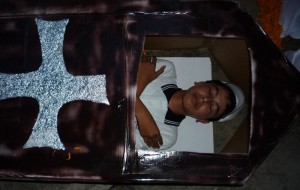This past week was very important for all Mexicans, especially for those in communities away from big cities who still preserve traditions and habits inherited from their pre-Hispanic ancestors.
The DÃa de Muertos celebration is really relevant for El Carrizal and neighboring communities, since it combines elements from indigenous as well as European customs. This festivity invites both living and dead relatives to celebrate life and death, to value our path here through this earth to the land of the Dead. The conceptualization of this idea is embodied in the Altares de Muertos (Altars for the Dead), which mix Catholic and indigenous beliefs.
During these days, altars are built in honor of the dead. They are composed of flowers, food, candles, and other elements. The conventional altar has nine steps, which in the pre-Hispanic tradition represented the nine stages that the departed had to descend in order to arrive in the domains of Mictlantecuhtli (God of Death). Nowadays, people also place an image of a saint, Catholic Virgin, or Jesus Christ on the upper step. On the middle steps, they position food and drinks that the deceased used to enjoy. On the lowest level, a path of flowers is placed from the house to the street; this path indicates the course the deceased needs to follow in order to reach his or her living relatives.
 |
 |
 |
|
Different altars made by local high-school students |
||
Our job at the community consisted in evaluating altars at the contests held at local schools. These activities are aimed to teach students the value of their own ancestral traditions and avoid the replacement of these celebrations with foreign customs, such as Halloween.



Excellente! Interesting article. I am a teacher and I have been to visit the elementary school of Santa Clara de Cobre where would like to return. I have traveled to Michoacan for the butterflies and fallen in love with the area. It is my dream to be there for El Dia De Los Muertos. I would like to get in touch with a group that is going there next year. Please let me know if you hear of such a group. Thank you
Honoring the dead is a wonderful way to teach students about their ancestry. I’d much rather see your approach than Halloween. Keep up the good work. You may not hear it often enough, but your work IS appreciated.
I’m not a huge fan of Halloween either. I come from Poland and our tradition also is to honor the dead rather than dress up and collect candy bars…
Honoring the dead is a wonderful way to teach students about their ancestry. I’d much rather see your approach than Halloween. Keep up the good work. You may not hear it often enough, but your work IS appreciated.
Very interesting article. It’s fun to read your articles greet. John.
This is a very interesting article. It is good that there is such a celebration that invites both living and dead relatives to celebrate life and death. Teaching those students would help them gain respect to the living and the dead.
Every country has there own tradition and different ways of celebrating it. Other countries/families don’t even celebrate so it really depends on the people living in that country. Education could be one of the best thing one person could ever have about the culture of the country where they are living.
DÃa de los Muertos or Day of the Dead is a unique observance deeply rooted in Hispanic tradition. The holiday focuses on the remembrance of loved ones passed, and is founded on the belief that once a year the souls of our dearly departed will return to earth.
The heart of any DÃa de los Muertos celebration is the building of altars. Ranging from simple to elaborate, these private altars are usually dedicated to a loved one, but not always. Elements of the altar incorporate personal items and photographs of the deceased and a variety of ofrendas or offerings such as marigold-like cempazúchitl flowers, prayer candles, and the favorite foods and beverages of the dearly departed. Sugar skulls, calaveras or skeletons and papel picado are often an integral part of the holiday.
The activities practiced today can be traced back some 3,000 years to the indigenous peoples of Mexico and Latin America. The Olmec, Zapotec, Mixtec, Aztec, and other peoples of ancient Mexico celebrated the death of loved ones. After the Spanish conquest, Christian beliefs were infused into native practices and became associated with the holy days of All Souls Day on November 1 and All Saints Day on November 2.
At first glance, the Mexican custom of El DÃa de los Muertos “the Day of the Dead” may sound much like the U.S. custom of Halloween. After all, the celebration traditionally starts at midnight the night of Oct. 31, and the festivities are abundant in images related to death.
El dÃa de los muertos, which continues until Nov. 2, has become one of the biggest holidays in Mexico, and celebrations are becoming more common in areas of the United States with a large Hispanic population. Its origins are distinctly Mexican.
Specifics of the celebration vary with region, but one of the most common customs is the making of elaborate altars to welcome departed spirits home. Vigils are held, and families often go to cemeteries to fix up the graves of their departed relatives. Festivities also frequently include traditional foods such as pan de muerto (bread of the dead), which can conceal a miniature skeleton.
The role the community plays in creating unique special events at the Museum of South Texas History cannot be overstated or over-appreciated. Every year, people from throughout the region join with the museum to demonstrate crafts, provide music and dance exhibitions, build Day of the Dead altars, help with children’s activities, and lend items from their private collections to make these one-day experiences extra special to the museum’s visitors.